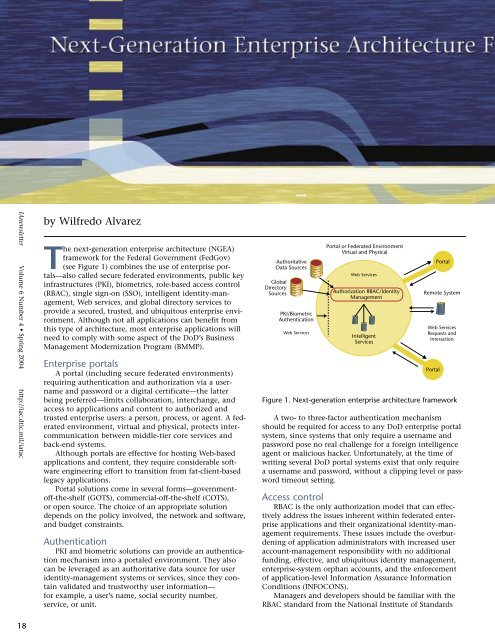Download - IAC - Defense Technical Information Center
Download - IAC - Defense Technical Information Center
Download - IAC - Defense Technical Information Center
You also want an ePaper? Increase the reach of your titles
YUMPU automatically turns print PDFs into web optimized ePapers that Google loves.
IAnewsletter Volume 6 Number 4 • Spring 2004 http://iac.dtic.mil/iatac<br />
by Wilfredo Alvarez<br />
The next-generation enterprise architecture (NGEA)<br />
framework for the Federal Government (FedGov)<br />
(see Figure 1) combines the use of enterprise portals—also<br />
called secure federated environments, public key<br />
infrastructures (PKI), biometrics, role-based access control<br />
(RBAC), single sign-on (SSO), intelligent identity-management,<br />
Web services, and global directory services to<br />
provide a secured, trusted, and ubiquitous enterprise environment.<br />
Although not all applications can benefit from<br />
this type of architecture, most enterprise applications will<br />
need to comply with some aspect of the DoD’s Business<br />
Management Modernization Program (BMMP).<br />
Enterprise portals<br />
A portal (including secure federated environments)<br />
requiring authentication and authorization via a username<br />
and password or a digital certificate—the latter<br />
being preferred—limits collaboration, interchange, and<br />
access to applications and content to authorized and<br />
trusted enterprise users: a person, process, or agent. A federated<br />
environment, virtual and physical, protects intercommunication<br />
between middle-tier core services and<br />
back-end systems.<br />
Although portals are effective for hosting Web-based<br />
applications and content, they require considerable software<br />
engineering effort to transition from fat-client-based<br />
legacy applications.<br />
Portal solutions come in several forms—governmentoff-the-shelf<br />
(GOTS), commercial-off-the-shelf (COTS),<br />
or open source. The choice of an appropriate solution<br />
depends on the policy involved, the network and software,<br />
and budget constraints.<br />
Authentication<br />
PKI and biometric solutions can provide an authentication<br />
mechanism into a portaled environment. They also<br />
can be leveraged as an authoritative data source for user<br />
identity-management systems or services, since they contain<br />
validated and trustworthy user information—<br />
for example, a user’s name, social security number,<br />
service, or unit.<br />
<br />
<br />
<br />
<br />
<br />
<br />
<br />
<br />
<br />
<br />
<br />
<br />
<br />
<br />
<br />
<br />
<br />
<br />
<br />
<br />
<br />
Figure 1. Next-generation enterprise architecture framework<br />
A two- to three-factor authentication mechanism<br />
should be required for access to any DoD enterprise portal<br />
system, since systems that only require a username and<br />
password pose no real challenge for a foreign intelligence<br />
agent or malicious hacker. Unfortunately, at the time of<br />
writing several DoD portal systems exist that only require<br />
a username and password, without a clipping level or password<br />
timeout setting.<br />
Access control<br />
RBAC is the only authorization model that can effectively<br />
address the issues inherent within federated enterprise<br />
applications and their organizational identity-management<br />
requirements. These issues include the overburdening<br />
of application administrators with increased user<br />
account-management responsibility with no additional<br />
funding, effective, and ubiquitous identity management,<br />
enterprise-system orphan accounts, and the enforcement<br />
of application-level <strong>Information</strong> Assurance <strong>Information</strong><br />
Conditions (INFOCONS).<br />
Managers and developers should be familiar with the<br />
RBAC standard from the National Institute of Standards<br />
18

















